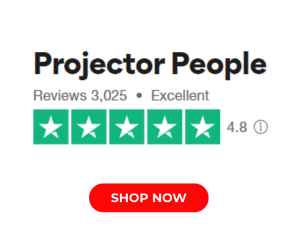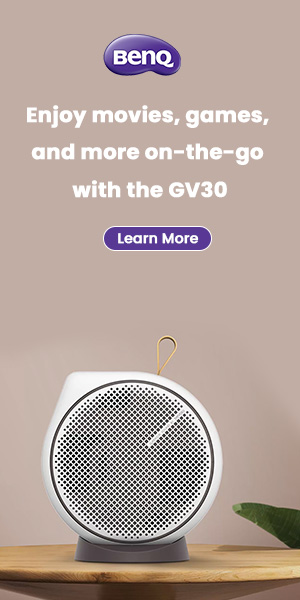Highly Recommended Award
Our Highly Recommended designation is earned by products offering extraordinary value or performance in their price class.
- Extremely accurate color
- 11-point grayscale controls
- 100% DCI-P3 color gamut and HDR10+ support
- 3D support
- Integrated streaming dongle with authorized Netflix app
- Vertical/horizontal lens shift
- Middling contrast
- Integrated dongle defaults to HDR for SDR content
An update to BenQ's popular HT3550 home theater projector for moderately dark rooms, the HT4550i brings a solid-state LED light source, 100% DCI-P3 color gamut coverage for HDR, and unusually good out-of-box and post-calibrated color accuracy for its $2,999 price.
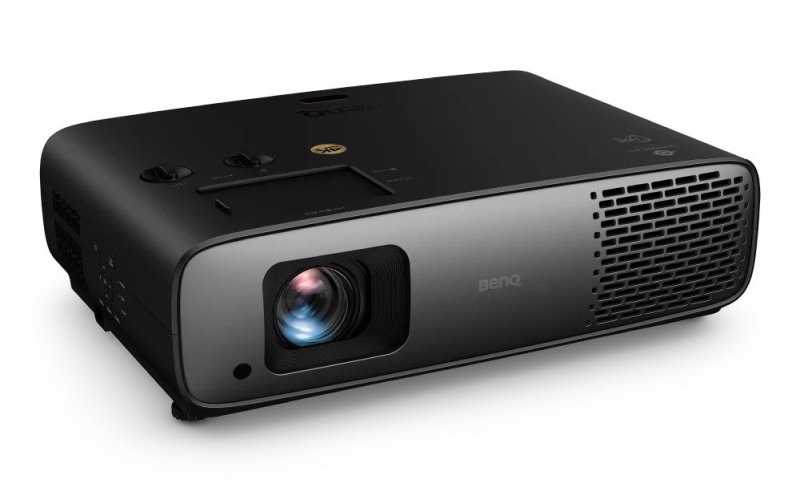
BenQ's HT4550i, released in May of this year, is the latest projector in the brand's Home Cinema lineup. Priced at the higher end of their offerings, the HT4550i retails for $2,999 and provides excellent performance and features while staying within a reasonable budget. It offers a 3,200 ANSI lumens brightness rating from a solid-state LED light source, along with 4K HDR compliance with HDR10+ support, 100% DCI-P3 coverage, certified Android TV streaming, and vertical and horizontal lens shift options. Let's see how the HT4550i performs in terms of its price-to-performance and how it compares to similarly priced units.
Features
The new BenQ HT4550i utilizes a relatively new Texas Instruments 0.65-inch DMD DLP chipset to achieve its 4K UHD resolution of 3840x2160 from a 1080p native array with four-phase pixel shifting. This resolves the 8.3 million pixels on the screen to display 4K resolution. During testing, the HT4550i thankfully provided a crisp and detailed 4K UHD image without demonstrating any rainbows, which can sometimes occur with single-chip DLP projectors.
Our sample's 4LED light source (RGGB, with an extra green LED for brightness) also exceeded the specified 3,200 ANSI lumens, measuring 3,413 ANSI lumens in its brightest picture mode. It's good to see an LED projector hit this kind of brightness, however, this mode is noticeably green-biased and its default color temp cannot be adjusted from the projector's Native setting to the more accurate Normal color temperature. Nevertheless, the best picture modes do measure well for accuracy and provided a fair amount of measured brightness and vibrant images. The light source has a long life of 20,000 hours in the Normal and SmartECO Light Source Modes, and 30,000 hours in ECO, ensuring years of use without the need for bulb replacements. The HT4550i has a published contrast specification of 2,000,000:1 with dynamic light source dimming, but its native contrast ratio without light source dimming measured at 900:1, which is relatively low and noticeable in content. However, the dynamic contrast does improve when SmartECO is used.
Weighing 14.55 pounds and measuring 16.54 x 5.31 x 12.28 inches (WHD), the HT4550i is not a lifestyle or portable projector but is still compact and lightweight enough to be moved around with ease. It supports various mounting options, including standard tabletop or ceiling for front- and rear-projection. BenQ offers its CM00G3 Universal Ceiling Mount as an option, with a $59 MSRP at the time of writing.
The HT4550i features optics with a 0% offset to the screen, so the centerline of the lens from a ceiling-mounted projector would be at the center of the projected image prior to being moved down by the available -60%vertical lens shift. Its lens has a 1.15-1.50:1 throw ratio for a 1.3x manual zoom and focus, which, thanks to smooth mechanical operation, made it easy to dial in the image. The throw ratio corresponds to approximately 2.4 feet to 32.6 feet, allowing projection of an image as small as 30 inches diagonal up to a massive 300 inches diagonal. I found the provided distance chart to be accurate. For my 100-inch diagonal image, the HT4550i was placed approximately 9.7 feet away, which aligns with BenQ's distance-to-screen chart.
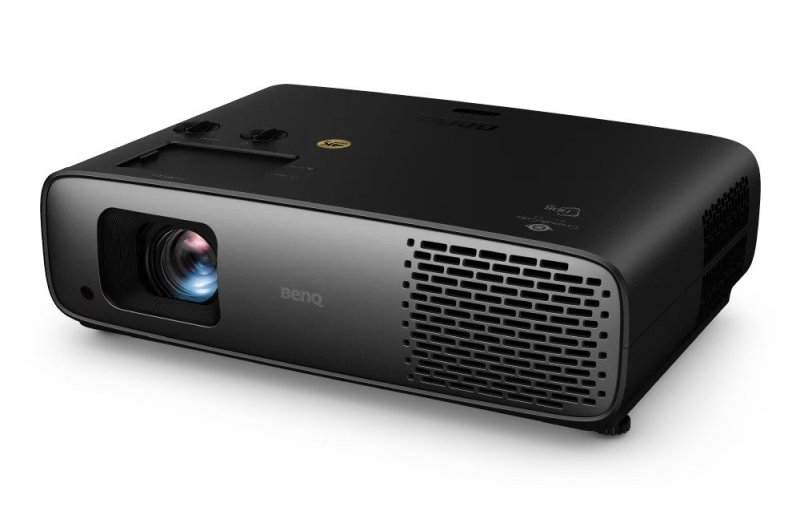
The HT4550i offers both vertical and horizontal lens shift capabilities. It provides a 0% to -60% vertical adjustment range and a ±15% horizontal shift. I did notice that at the upper end of the vertical lens shift range, the image would actually move up and to the right slightly. This could be somewhat corrected using the horizontal shift; however, vertical lens shift should ideally only influence the vertical axis. Additionally, a 2D keystone adjustment is provided, allowing for a ±30-degree adjustment in both vertical and horizontal keystone. It is important to note that utilizing any form of digital keystone or warping can impact image integrity, so it is advised to take the extra time needed to install the projector in a way that avoids the use of keystone. However, in temporary installations, it can be a viable solution. To determine the installation location and throw distance for your preferred screen size, please reference the ProjectorCentral BenQ HT4550i Projection calculator.
The HT4550i utilizes BenQ's Cinematic Color DCI-P3 technology, enabling full 100% coverage of the DCI-P3 and Rec.709 color space through the use of a Wide Color Gamut (WCG) Filter. BenQ provides a factory calibration report showing the unit's coverage to these specifications within the color gamut. The report does not display the DeltaE—the error—of the points used to measure this coverage. BenQ says the tolerance of their automated calibration insures a Rec.709 DeltaE of less than 3, which is acceptably low, and that measuring and printing the precise dE for each measurement point would impact production speed. However, the report does provide the coverage of the color gamut, the Picture Modes that cover them, the test conditions, and the gamma tracking.
Fortunately, when measured, the HT4550i does prove to be very accurate and achieves the promised 100% coverage of both the DCI-P3 and Rec.709 color space, which will be covered in more detail in the Performance section. The HT4550i also features BenQ's HDR-PRO technology to facilitate HDR tone-mapping and contrast. A feature called Local Contrast Enhancement utilizes the LED light source to enable 1000+ local-dimming zones to adjust bright and dark detail. This works alongside Dynamic Black dynamic contrast. Consequently, the projector excelled in displaying HDR scenes that are dark or have very bright highlights, where the HT4550i maintained a higher APL (Average Picture Level) for the image while preserving detail that would otherwise be clipped with less effective tone-mapping.
Support for HDR10+ dynamic frame-by-frame tone-mapping is also provided, and automatically enabled when an HDR10+ signal is received, which in turn disables the Local Contrast Enhancer. Here again, the resulting image is of high quality, maintaining good APL, color luminance, and saturation. Additionally, to ensure the highest possible accuracy, the HT4550i provides an 11-point white balance control for calibration, along with the standard 2-point controls, and includes the Filmmaker Mode picture mode seen now on many displays, which is designed to preserve the director's creative intent.
The HT4550i includes BenQ's QS02 Android TV dongle, which is meant to be placed in a hidden rear compartment of the HT4550i. It attaches to an internal mini-HDMI input and micro-USB for power. Once connected, the standard Android TV setup process begins, which only takes a few minutes to complete. Accompanying the QS02 dongle is a dedicated Android TV remote used to navigate the Android TV interface and quickly launch applications such as the authorized Netflix app, YouTube, Prime Video, and Disney+. The included Android TV dongle supports the normal features one would expect from an Android device, including Chromecast built-in, wireless display casting, Google Voice Assistant, and access to the Google Play Store. The internal apps also support HDR10+.
The main issue I found with the dongle is that it does not track and match the dynamic range of content. It automatically defaults to HDR no matter the content type, which causes all SDR content to display in HDR. BenQ says the only go-around is to go three pages into the Android menu settings and manually set the Color Space to one of the 8-bit options, which will cause SDR to display as SDR. You would then have to reset the color space back to one of the 10- or 12-bit options to get it to output HDR again. This is awkward and inconvenient. Therefore, if HDR is pretty much all you watch, the QS02 dongle may work well for you, but if a user also watches a significant amount of SDR content, it may be worthwhile to use an external streaming device.
The I/O of the HT4550i provides ample connectivity options, including two full-size rear panel HDMI 2.0b/HDCP 2.2 ports with one supporting eARC, plus the hidden mini-HDMI port for the QS02 dongle. Additionally, the projector offers two USB 2.0 Type A ports, one of which supports 2.5A power delivery and is labeled as Service, while the other supports 1.5A power delivery and is designated as Media Reader. There is also a SPDIF optical port and 3.5 mm analog Audio Out for external audio devices to be used in lieu of the HDMI eARC function, an RJ-45 LAN port, a RS-232 connection, and a 12V trigger.
Adding to its versatility is the HT4550i's built-in, 5-watt mono, treVolo-tuned chamber speaker. BenQ's treVolo tuning has performed well in the past in other projectors and here is no exception, as the projector offered surprisingly good output considering it comes from a single 5-watt speaker. The audio menu offers five different Sound Modes, including a user mode with a 5-band EQ. However, an external sound system is always recommended for the best experience, either a soundbar, a dedicated AVR or AVP-based system, or even a robust Bluetooth speaker. But in a temporary setup, the internal speaker may suffice.
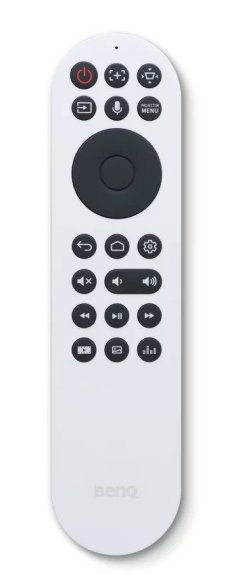
The HT4550i supports 3D via DLP-Link glasses, which is welcome considering how rapidly this feature seems to be disappearing from enthusiast projectors, and especially when it is mated as it is here with good brightness and minimal-to-no crosstalk. Another nice plus is 24P playback support with BenQ's 24P True Cinema motion enhancement to reduce judder in 24 Hz film sources. MEMC frame interpolation is also on board for signals up to 4K/60 Hz. And the projector includes a Fast Mode feature to minimize latency for gaming, down to a rated 17.9 ms input lag with 4K/60 or 1080p/60 signals.
The main projector remote included with the HT4550i is backlit with dedicated buttons for picture modes, sound modes, mute, volume, and transport functions such as play, pause, forward, and rewind. The remote can also navigate the internal Android TV dongle when connected, with additional buttons such as Home, settings, back, and voice assistant. Other buttons control the HT4550i itself, including keystone, input, projector menu, and power. There's also an auto-focus button for compatible projectors that support that feature, though the HT4550i isn't one of them. Overall, the remote is responsive, has a wide effective range, and easily controls the HT4550i.
Performance
Color Modes. The BenQ HT4550i offers an unusually broad mix of 12 picture modes, some of which are specific to content type, and two of which are ISF modes that require the ISF unlock code to access. The available modes for SDR include Bright, Bright Cinema, Cinema, Filmmaker Mode, and User; unlocking the ISF Day and ISF Night modes will add them to the SDR options. For HDR content, the HT4550i provides HDR10, HDR10+, Filmmaker Mode, and HLG modes, while 3D content has its own dedicated picture mode. Certain picture modes have specific settings that are enabled or disabled by default and cannot be changed. For example, Filmmaker Mode has the WCG Filter enabled and it is grayed out in the menu, preventing its deactivation, while Cinema mode has the WCG Filter disabled and also grayed out, preventing its activation. The same scenario applies to HDR10+, where the Local Contrast Enhancer setting is off by default and grayed out to prevent its activation. This makes sense since the dynamic HDR metadata provided by HDR+ encoding should take precedence over the projector's own HDR tone mapping.
The picture modes of the HT4550i were actually pretty accurate out of the box, the exception being Bright Cinema, which had a green bias due to its use of the projector's Native color temperature. Otherwise, this statement held true for both SDR and HDR content as long as the picture mode selected used the Normal color temperature. However, the color points for gamut, particularly the saturation in HDR, showed reduced accuracy when the WCG Filter was not used. The upside of not utilizing the WCG Filter is higher brightness, as activating it reduced overall measured brightness by 36-38%.
In SDR, the color tracking was relatively close to accurate, with some slight deviations in Cyan's hue and some saturation issues with Yellow. The User mode was an exception in SDR, as enabling the WCG filter extended the color gamut well beyond Rec.709 and tracked DCI-P3, thereby reducing its accuracy with Rec.709 content. When the WCG filter was engaged, the color gamut coverage indeed reached or exceeded 100% for both DCI-P3 and Rec.709.
Just looking by eye out of the box, the most pleasing and accurate picture modes were Cinema and Filmmaker, both of which tracked grayscale very well. Gamma tracking was correct in all instances, regardless of the menu selection.
The calibration facilities in the HT4550i are substantial, including a standard 2-point white balance control plus an 11-point white balance control with increments of 10-100% as well as 5%. The projector also provides a standard CMS for control over primary and secondary colors, including Hue, Saturation, and Brightness sliders. It's important to note that enabling the ISF modes disables the 11-point white balance controls. Therefore, apart from the benefit of having locked settings hidden behind the ISF unlock code, there is little reason to use them, as more control is available in other picture modes. I did find the 11-point controls were slightly too coarse, resulting in significant changes from a single click. BenQ would do well to provide a more granular adjustment here.
If you are skipping calibration, the ideal picture modes to watch on the HT4550i would be either Filmmaker or Cinema for SDR, with Cinema being the brighter option as it doesn't use the WCG filter. For HDR content, HDR10+ would be the most ideal picture mode when you have that option with HDR10+ encoded content. Though, if you are trying to optimize brightness, HDR10 can be used, and Filmmaker mode is ideal when the primary focus is on accuracy and dark room viewing with regular HDR10 content. The only recommended adjustments would be to the Local Contrast Enhancer, with the Middle setting working best, and I'd suggest setting the Light Source Mode to either Normal or SmartECO. Again, as long as the Normal color temperature is used, the picture will be fairly accurate.
For calibration, I used Calman Ultimate calibration software from Portrait Displays, a Colorimetry Research CR-250 Spectroradiometer, a Colorimetry Research CR-100 Colorimeter, and a Murideo 8K Seven Generator. The HT4550i was calibrated to a 100-inch diagonal image on a Stewart Filmscreen Studiotek 130 G4 screen. Prior to calibration, I ran various measurements to confirm my observations from the out-of-the-box viewing experience.
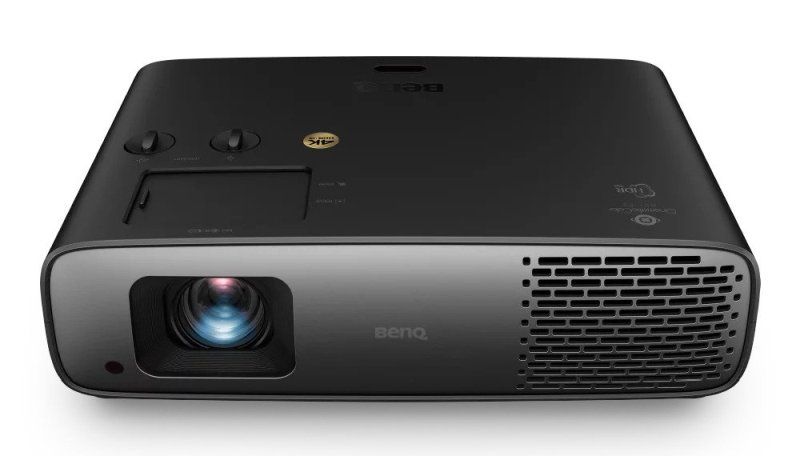
In keeping with what I initially saw on on-screen, the pre-calibration measurements for the HT4550i were generally very good, with accurate grayscale and color reproduction. The measured dE values confirmed this. (DeltaE, or dE, is the metric used to determine visible errors, with a value above 3 being visible, above 2.3 being a just noticeable difference for trained eyes, and below 2.3 ideally not visible to the naked eye.)
In Filmmaker Mode picture mode with the color temperature set to Normal, the average grayscale dE was 1.5, with a maximum of 3.5. The gamut/color points had an average dE of 2.1, with a maximum of 4.7, and a Color Checker that sampled more than 150 color swatches showed an average dE of 2.3 with a maximum of 6.5. I was pleased to find that the HT4550i was easily dialed in for even lower errors and greater accuracy for both SDR and HDR. Post-calibration, the grayscale DeltaE averaged 1.2 with a maximum of 2.9, while the gamut showed an average dE of 1.0 and a maximum of 1.6. For the large-size ColorChecker, the average DeltaE was 1.1, with a maximum of 3.4. In HDR content, the grayscale and color gamut averaged between 3.9 and 4.9 dE.
HDR measurements looked fairly good, though there were the usual deficiencies in HDR luminance common to projectors. The biggest take away from the HDR calibration was that using HDR10 mode without activating the WCG filter gets you much closer to the target for luminance while sacrificing color accuracy, specifically within green saturation and hue. Utilizing the WCG filter will result in more accurate color, but with higher luminance errors.
The sources I used for reviewing content post-calibration were an AppleTV 4K, and an Oppo UDP-203 Ultra HD Blu-ray player.
Need a Lamp for Your Projector?
Browse ProjectorCentral's hand-picked list of Certified Lamp Sellers to find the right lamp at the best price.
Shop Lamps
1080p/SDR Viewing. During my evaluation of SDR, I watched Dazed and Confused on Blu-ray via the Oppo UHD player. The entire presentation looked great, with accurate colors in everything from clothing to cars, such as Pickford's Orange Pontiac GTO. There's a small amount of film grain present in certain scenes on this transfer, such as in a shot taken at dusk of a baseball field, and I appreciated that the grain was preserved. Skin tones appeared natural throughout, and the image had a good sense of depth overall.
1080p/SDR 3D Viewing. For 3D viewing, I watched the animated Monsters vs Aliens off the Oppo player using standard DLP-Link 3D glasses. The 3D image quality was actually quite good, with very high brightness and no visible crosstalk. Impressive depth was showcased in various scenes, such as when Susan wakes up in her cell before meeting the monsters and the camera view pans back, or when W.R. Monger is flying around on his jetpack. When the projector sees 3D content, it defaults to its 3D picture mode and locks in the Normal Light Source Mode, which is a good thing since the bright image was ideal for 3D. The colors looked good and vibrant, and the image had a nice amount of contrast even through the glasses. Overall, watching 3D was a very pleasant experience on the HT4550i.
4K/HDR Viewing. For my 4K/HDR auditions, I watched The Tomorrow War from Amazon Prime Video on both the AppleTV 4K and off the supplied Android TV dongle. While watching off the Apple TV, I switched between HDR10 and Filmmaker Mode. With HDR10, I opted for a brighter image without using the color filter, while in Filmmaker Mode, the Color Filter was engaged by default. I then watched the HDR10+ dynamic tone-mapped version off the projector's Android dongle.

The regular HDR10 version in either HDR10 mode or Filmmaker provided a good picture with accurate skin tones and hues. Using HDR10 mode without the WCG filter gave me a brighter, more vibrant picture, which really stood out toward the end of the movie when Dan (Chris Pratt) and his father James (J.K. Simmons) were in the snow fighting the alien Whitespike. The whites of the snow were clean and the flesh tones were accurate. I did notice that setting the projector's HDR Brightness control to any level higher than 0 would result in clipping detail in the snow. On this scene, the slightly lower brightness associated with Filmmaker Mode, which utilizes the WCG filter, enabled more detail to be retained in the snowy background. However, both picture modes presented a large amount of clipping in the sun just before Whitespike went off the edge of the cliff. The HDR10+ presentation, with its dynamic metadata, provided more detail with less clipping overall from a picture that was equally bright as the HDR10 picture mode that didn't use the filter. This was expected since the HDR10+ mode does not engage the WCG filter by default.
I did some HDR viewing of Prometheus, a classic black-level/contrast test, on 4K Blu-ray via the Oppo 203 UHD player. The movie's colors were reproduced extremely well, from the subtle lights of the ship interior to the warm yellow hues in the helmet lights. The presented image was very sharp and detailed, although darker scenes easily revealed the projector's less-than-stellar contrast and black level with demanding content. The issue I found was that you could adjust the image to either crush black to get things darker, or resolve more shadow detail at the expense of lifting the entire black floor. There was no really good in-between. So in certain scenes, such as the early shot when David (Michael Fassbender) is alone in the ship while the other passengers are in stasis, or on shots of the ship traveling through space, the blacks appeared lifted and didn't really show as black. Using the Local Contrast Enhancer helped in exposing more stars during the ship's travel scenes but lightened the image a bit too much in darker areas. Nonetheless, employing this feature did provide a more pleasing viewing experience.
For my final HDR viewing, I watched The Witcher, Season 2, Episode 3 from Netflix, specifically the scene where Ciri was training before transitioning into the dining hall of the Witchers. Again, I switched between HDR10 and Filmmaker Mode. The WCG color filter active in Filmmaker Mode resulted in a better overall image, providing accurate skin tones and revealing subtle colors from the sun cast on Ciri and Geralt's faces. This good performance held true even when they transitioned into the dining hall where the fire is displayed in the cauldron. The flames appeared rich and well-rendered, unlike with many projectors where flames appear white or otherwise lack color. Reducing the HDR Brightness setting to -1 added more depth to the overall image and suited the show well during the episodes I watched.
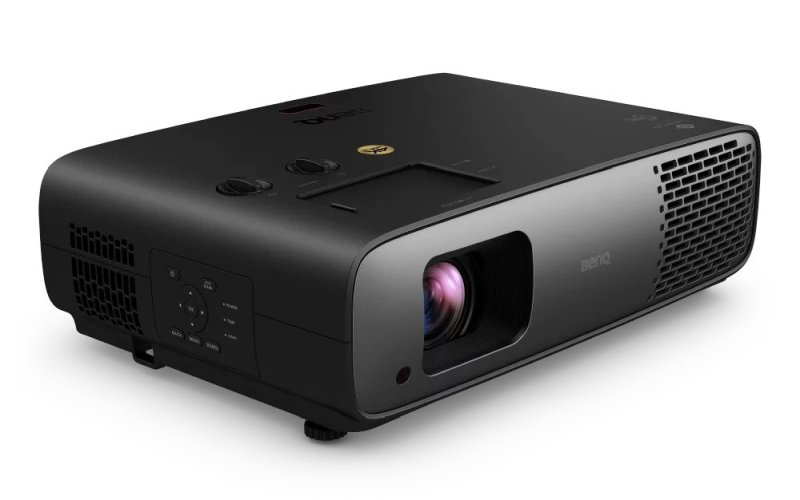
Conclusion
The BenQ HT4550i is a well-rounded and solid performer that doesn't seriously lack in any particular area compared to other projectors in its price range. BenQ obviously went to some lengths to make sure the projector delivers a cinema-like experience, and included features that home theater enthusiasts will appreciate, such as 4K HDR with effective HDR tone-mapping and HDR10+ support, full P3 gamut coverage, and extremely accurate and robust calibration controls with an 11-point grayscale adjustment. They even included a certified Android TV dongle with authorized Netflix, and made sure the projector has respectably low latency for gamers.
However, the HT4550i falls into an interesting space around its $2,999 price, an area mostly populated these days by laser ultra-short throw projectors but where you can still find some decent traditional home theater projectors with a lot of the same features. That's not to say they come to the table with the same overall performance—some may do better or worse in certain areas. But there are other options where you could spend the same amount, or a bit less, or a bit more, and end up with features like motorized lens controls, a laser light engine that offers similar benefits to the HT4550i's LED source, HDMI 2.1, and possibly better performance in some key areas like contrast.
That said, you'll have to look hard to find everything BenQ has packed in here, and on top of this the HT4550i will be brighter in many instances than its competition in its best, most accurate picture modes. The HT4550i is also generally one of the more accurate projectors I've tested at this price, and one of the few capable of covering 100% of the DCI-P3 color space while maintaining good color accuracy. It's a worthy contender in its category, and should be on your short list for a close look if you're looking for a dedicated home cinema projector in this budget bracket.
Measurements
Brightness. The BenQ HT4550i is rated for 3,200 ANSI lumens. The brightest picture mode is Bright, which had a strong green bias and measured 3,413 ANSI lumens, or a bit less than 7% above the rated spec. Most other picture modes were more accurate but measured considerably lower lumen output.
Selecting Custom for the Light Source Mode measured a 7.3% light decrease vs. the Normal mode, while selecting ECO measured a 25.4% light decrease, and Smart ECO measured a 27% light decrease from Normal mode. Use of the WCG filter resulted in an approximately 36-38% loss of brightness in return for the wider DCI-P3 color gamut.
BENQ HT4550I ANSI Lumens
| SDR/HDR Mode | Normal | Custom 100 | ECO | Smart ECO |
|---|---|---|---|---|
| Bright | 3,413 | 3,163 | 2,546 | 2,491 |
| Bright Cinema | 1,895 | 1,756 | 1,413 | 1,383 |
| Cinema | 1,873 | 1,736 | 1,397 | 1,367 |
| Filmmaker Mode | 1,177 | 1,091 | 878 | 859 |
| User | 1,177 | 1,091 | 878 | 859 |
| HDR10 | 1,881 | 1,743 | 1,403 | 1,373 |
| Filmmaker (HDR) | 1,908 | 1,769 | 1,423 | 1,393 |
| HDR 10 (WCG) | 1,188 | 1,101 | 886 | 867 |
| Filmmaker (HDR/WCG) | 1,178 | 1,092 | 878 | 860 |
Zoom Lens Light Loss. The BenQ HT4550i exhibited a 25.6% light loss when moving from Wide to Telephoto lens position on its 1.3X zoom lens.
Brightness Uniformity. The BenQ HT4550i projecting a 100-inch diagonal image resulted in measured brightness uniformity of 84%. The brightest portion of the screen was the Middle Bottom sector, and the dimmest the Left Top sector. The difference in brightness on a full white and solid color screens wasn't noticeable on a full white screen or in actual content.
Fan Noise. BenQ rates the HT4550i's noise level at 32 dB typical and 28 dB in Eco mode, using the industry-standard 6-point averaged measurement in a soundproof booth. ProjectorCentral's casual, real-world measurements always track higher than the factory measurements. In the case of the HT4550i, fan noise was typically not consistent but will track up and down based on usage. In my casual measurements using Room EQ Wizard software and a Umik-1 microphone, taking measurements at approximately four feet from the left, right, and rear sides of the projector, the highest, peak noise averaged 43.2 dBA in Normal power mode, 37.4 dBA in ECO/Smart ECO, and 38.4 dBA in Custom. Measurements were consistent across all SDR and HDR picture modes within each power setting. My theater room ambient noise floor measured at 33.3 dBA.
Input Lag. Input lag measurements were done with the projector's Fast Mode active and registered as follows for the different supported signal types: 1080/60 = 19ms, 1080/120 = 22ms, 1080/240 = 11ms, 4K/60 = 19ms.
Connections
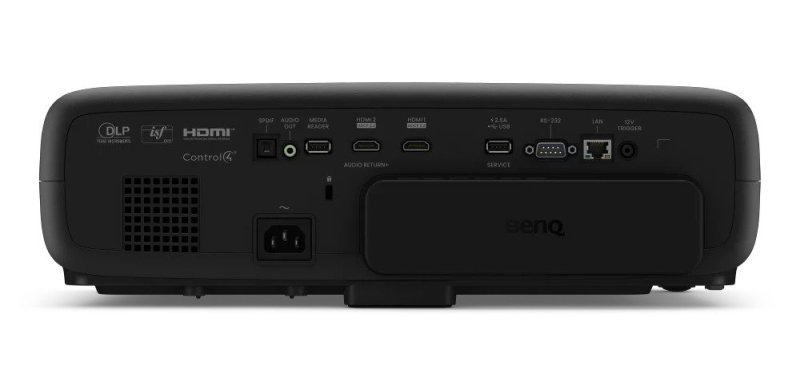
- HDMI 2.0b (x2; HDCP 2.2; 1 with ARC)
- HDMI 2.0b (used for android dongle)
- USB 2.0 Type A (x2; 2.5-amp power delivery/Service; Media Playback)
- SPDIF (optical port)
- 3.5mm Audio Out
- 12v trigger
- RJ-45 Lan port
- RS-232
Calibrated Settings
Calibrated image settings from any third-party do not account for the significant potential for sample-to-sample variation, nor the different screen sizes and materials, lighting, lamp usage, or other environmental factors that can affect image quality. Projectors should always be calibrated in the user's own space and tuned for the expected viewing conditions. However, the settings provided here may be a helpful starting point for some. Always record your current settings before making adjustments so you can return to them as desired. Refer to the Performance section for some context for each calibration.
Note: To provide a brighter image in HDR the picture mode, HDR10 does not use filter at the expense of some accuracy, while Filmmaker Mode makes use of filter though with a dimmer image.
SDR
Picture Mode: FILMMAKER MODE
Fast Mode: Off
Brightness: 49
Contrast: 42
Color: 50
Tint: 50
Sharpness: 0
Advanced Color Settings
Gamma Selection: 2.4
Color Temperature Tuning
Color Temperature: Normal
R Gain: 101
G Gain: 100
B Gain: 101
R Offset: 256
G Offset: 256
B Offset: 256
Adv. Color Temperature Tuning
| R | G | B | |
|---|---|---|---|
| 5% | 56 | 50 | 49 |
| 10% | 51 | 50 | 50 |
| 20% | 50 | 51 | 48 |
| 30% | 49 | 50 | 53 |
| 40% | 48 | 50 | 50 |
| 50% | 46 | 50 | 50 |
| 60% | 50 | 50 | 49 |
| 70% | 46 | 50 | 50 |
| 80% | 50 | 50 | 49 |
| 90% | 50 | 50 | 51 |
| 100% | 49 | 50 | 50 |
Color Management
| Hue | Saturation | Gain | |
|---|---|---|---|
| R | 246 | 192 | 159 |
| G | 127 | 165 | 182 |
| B | 175 | 193 | 182 |
| C | 243 | 124 | 196 |
| M | 121 | 164 | 182 |
| Y | 185 | 163 | 191 |
| W | 200 | 200 | 200 |
Wide Color Gamut: ON
Cinema Master
Color Enhancer: 0
Flesh Tone: 0
Pixel 4K Enhancer: 2
Motion Enhancer 4K: Off
Local Contrast Enhancer: Low
Light Source Mode: Custom
Custom Brightness: 100
HDR Brightness: 0
Noise Reduction: Low
HDR (WCG OFF)
Picture Mode: HDR10
Fast Mode: Off
Brightness: 50
Contrast: 50
Color: 50
Tint: 50
Sharpness: 0
Advanced Color Settings
Gamma Selection: 2.2
Color Temperature Tuning
Color Temperature: Normal
R Gain: 100
G Gain: 100
B Gain: 100
R Offset: 256
G Offset: 256
B Offset: 256
Adv. Color Temperature Tuning
| R | G | B | |
|---|---|---|---|
| 5% | 50 | 50 | 50 |
| 10% | 50 | 50 | 50 |
| 20% | 50 | 50 | 50 |
| 30% | 50 | 50 | 50 |
| 40% | 50 | 50 | 57 |
| 50% | 50 | 49 | 50 |
| 60% | 50 | 50 | 53 |
| 70% | 49 | 50 | 50 |
| 80% | 49 | 49 | 50 |
| 90% | 50 | 50 | 52 |
| 100% | 48 | 48 | 57 |
Color Management
| Hue | Saturation | Gain | |
|---|---|---|---|
| R | 200 | 207 | 200 |
| G | 200 | 200 | 200 |
| B | 209 | 201 | 200 |
| C | 143 | 200 | 227 |
| M | 204 | 209 | 200 |
| Y | 206 | 226 | 196 |
| W | 200 | 223 | 200 |
Wide Color Gamut: OFF
Cinema Master
Color Enhancer: 0
Flesh Tone: 0
Pixel 4K Enhancer: 4
Motion Enhancer 4K: Off
Local Contrast Enhancer: Mid
Light Source Mode: Normal
Custom Brightness: N/A
HDR Brightness: 1
Noise Reduction: Low
HDR (WCG ON)
Picture Mode: FILMMAKER MODE
Fast Mode: Off
Brightness: 50
Contrast: 50
Color: 50
Tint: 50
Sharpness: 0
Advanced Color Settings
Gamma Selection: 2.2
Color Temperature Tuning
Color Temperature: Normal
R Gain: 100
G Gain: 100
B Gain: 100
R Offset: 256
G Offset: 256
B Offset: 256
Adv. Color Temperature Tuning
| R | G | B | |
|---|---|---|---|
| 5% | 50 | 50 | 50 |
| 10% | 50 | 50 | 50 |
| 20% | 50 | 50 | 50 |
| 30% | 50 | 50 | 50 |
| 40% | 50 | 50 | 53 |
| 50% | 50 | 48 | 52 |
| 60% | 49 | 50 | 50 |
| 70% | 50 | 49 | 52 |
| 80% | 50 | 50 | 50 |
| 90% | 50 | 50 | 50 |
| 100% | 50 | 50 | 50 |
Color Management
| Hue | Saturation | Gain | |
|---|---|---|---|
| R | 200 | 219 | 209 |
| G | 175 | 225 | 205 |
| B | 206 | 233 | 200 |
| C | 162 | 202 | 200 |
| M | 200 | 235 | 200 |
| Y | 212 | 226 | 200 |
| W | 200 | 200 | 200 |
Wide Color Gamut: ON
Cinema Master
Color Enhancer: 0
Flesh Tone: 0
Pixel 4K Enhancer: 6
Motion Enhancer 4K: Off
Local Contrast Enhancer: Mid
Light Source Mode: Normal
Custom Brightness: N/A
HDR Brightness: 0
Noise Reduction: Low
For more detailed specifications and connections, check out our BenQ HT4550i projector page.
To buy this projector, use Where to Buy online, or get a price quote by email direct from Projector Central authorized dealers using our E-Z Quote tool.
The BenQ HT4550i is also sold outside of the United States of America as the BenQ W4000i. Some specifications may be slightly different. Check with BenQ for complete specifications.
Thanks for the thorough review. In the color calibration settings, what does the color "W" represent and how do you calibrate for that setting? I familiar with what RGBCMY represent and how to calibrates those settings. Please let me know. Thanks!
Is there a way to confirm that this is actually the correct alignment for the lens shift? I know a lot of readers may be concerned and would like to have the projector a few inches above the top of their screen if that is possible.
"The HT4550i does use RGGB 4LED design to enhance the brightness (see BenQ knowledge article here: https://www.benq.com/en-us/knowledge-center/knowledge/why-you-should-choose-4led-projectors-and-their-long-lasting-colors.html)
"Between the choice of RGGB and RGBB, it depends on several factors on the engineering side, and we find the best balance between brightness and color accuracy on each different model platform."
https://www.facebook.com/groups/projectorcentralsgroup/




